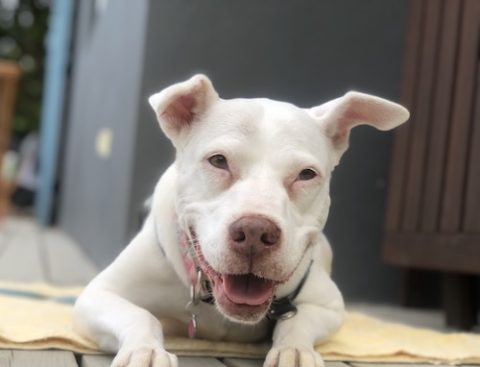How I trained my deaf dog (And how you can train your deaf dog, too)!
Are you a deaf dog pet parent? Do you struggle when it comes to training your dog?
 About nine years ago, Blanca (my deaf pup), came into my life after she was rescued from the streets of Puerto Rico. Due to her having been homeless with minimal interactions with people, Blanca was mouthy, jumpy, and overly excited around humans. In fact, she was so enthusiastic to see people that she would leap up with her front paws and put your arm in her mouth.
About nine years ago, Blanca (my deaf pup), came into my life after she was rescued from the streets of Puerto Rico. Due to her having been homeless with minimal interactions with people, Blanca was mouthy, jumpy, and overly excited around humans. In fact, she was so enthusiastic to see people that she would leap up with her front paws and put your arm in her mouth.
As a professional dog trainer and animal behavior consultant I knew that I could work with her incorporating patience and positive reinforcement training techniques. At the start I was using a standard auditory clicker as a marker as we hadn’t yet figured out that Blanca was deaf! In hindsight she was responding to my mechanics, timing, and the yummy treats in my pouch vs. any sound she could (or could not!) hear!
Whatever issues you might like to work on, or even it you just want to learn how to train more effectively, the following protocol is the cornerstone to set everyone up for success.
The three most critical steps when trying to train your dog are the following.
Step one is to always avoid rehearsing the unwanted behavior. This may mean using a baby gate or a leash so that your dog doesn’t have the chance to practice the unwanted behavior–thus getting better at it.
The next step is to reinforce behaviors that you like which your pup already offers—such as, four paws on the floor!
The final step is to separately teach an incompatible or an alternative behavior. This new behavior will ultimately become your dog’s go-to response if you build a long and strong reinforcement history for it. For example, if your dog is a jumper, this means that instead of meeting people and jumping up on them your dog will automatically default to offering the new behavior (that you do like) for greetings.
With respect to Blanca’s training, I loaded up my treat pouch full of hotdogs and cheese–ostensibly high value items for most dogs–and began marking and reinforcing her for keeping her feet planted on the ground and or her bottom on the floor. By marking and reinforcing these incompatible behaviors I was able to teach her what I wanted her to do instead—and made these new behaviors “worthwhile” from her perspective!
If you are struggling to train your deaf dog, or if you are getting frustrated by the overwhelming amount of information out there, I am excited to announce that my Deaf Dog training course has launched!
In this course I will work step-by-step with you on how to effect behavioral change using modern, effective, positive reinforcement training methods. The course specifically covers issues, such as: mouthiness, counter surfing, crate training, and loose leash walking.
Additionally you will learn…
- The secrets of training like a professional.
- The way to understand how to change behavior while increasingly building a positive relationship and avoiding dangerous consequences of outdated aversive methods.
- The keys to improve your skills to have better communication with your deaf pup.
- The route to gain better awareness about how to reinforce those behaviors you want to see more of.
- The path to create opportunities for a better relationship with your deaf dog!
The deaf dog training course is full of lessons, demos, and hands-on practical videos.
To sign up for the course follow this link and use the code LAUNCH to receive 10% off (limited quantity and only for the next 48 hours).
Happy Training!
